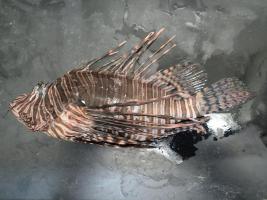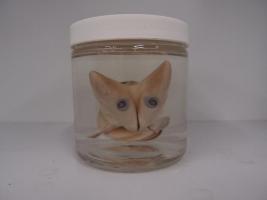Vertebrates - Fish
Phylum: Chordata Classes: Agnatha, Chondrichthyes, Osteichthyes
Fish are aquatic vertebrates that generally have scales and two sets of paired fins. They show a huge variety of shape and size and occur in all aquatic habitats. The jawless Agnatha or lampreys and hagfish are the most primitive type of fish with no paired fins, there are around 100 species. Chondrichthyes are fish with a cartilaginous skeleton, there are around 970 species. They have been around for over 400 million years and can be found in seas all over the world. The Osteichthyes or fish with bony skeletons make up the majority of fish with around 30,000 known species.
For more information on fish in general click here
Trinidad & Tobago Fish
Over one thousand species of marine fish have been recorded from around T&T. Sharks and rays show a wide variety of forms from stingrays with venomous barbs to giant whale sharks gulping plankton in the open sea. Some species can be found in estuarine conditions at the mouths of rivers. Local bony fish also have a huge range of body shapes and sizes from tiny sea horses sheltering in amongst coral reefs to large shoals of fast moving ocean predators like the tuna. Marine fish are an important food source in Trinidad with the most popular species being the kingfish and the carite. Fishing is also a common recreational activity with many people doing it from the beach. Game fishing for marlin and sailfish out in the open sea is popular with tourists and some locals.
Despite the fact that almost half of the fish worldwide are freshwater, only around seventy species are found in our streams and rivers. This is typical biogeography for a continental island. Many of our freshwater species actually live in the brackish waters of swamps, mangrove forests and estuaries. The most famous Trinidadian fish is probably the guppy, Poecilia reticulata, discovered by R.J.L Guppy in 1866. It is now a very popular aquarium species and has been selectively bred for different colours and tail shapes. For a guide to the freshwater fish of Trinidad & Tobago click here.
For profiles of selected species click here
UWIZM Collections
The collections of fish in the UWIZM are quite extensive with most of the local freshwater species represented with multiple specimens. and a wide range of marine species including some deepwater specimens. There are over 1,200 lots of bony fish from around 104 families and around 20 lots of sharks and rays from 10 families.
Families in the collections include:
Acanthuridae, Achiridae, Albulidae, Ariidae, Atherinidae, Batrachoididae, Belonidae, Blenniidae, Bothidae, Callichthyidae, Carangidae, Carcharhinidae, Centropomidae, Chaetodontidae, Characidae, Cichlidae, Clupeidae, Congridae, Diodontidae, Echeneidae, Eleotridae, Elopidae, Engraulidae, Exocoetidae, Fistulariidae, Gasteropelecidae, Gerreidae, Gobiesocidae, Gobiidae, Hemmiramphidae, Heptapteridae, Labridae, Labrisomidae, Monacanthidae, Mormyridae, Mugilidae, Mullidae, Muraenidae, Ostracidae, Poeciliidae, Polynemidae, Pomacanthidae, Pomacentridae, Pomadasyidae, Rivulidae, Scaridae, Sciaenidae, Scombridae, , Stromateidae, Synbranchidae, Syngnathidae, Synodontidae, Tetraodontidae, Torpedinidae, Triakidae, Trichiuridae
Highlights
Lionfish (Pterois volitans) caught on the north coast of Trinidad
Juvenile shark with two heads
| Back to The Collections |
Last updated 7 June 2018








